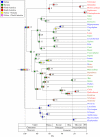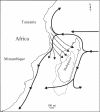The historical biogeography of Mammalia
- PMID: 21807730
- PMCID: PMC3138613
- DOI: 10.1098/rstb.2011.0023
The historical biogeography of Mammalia
Abstract
Palaeobiogeographic reconstructions are underpinned by phylogenies, divergence times and ancestral area reconstructions, which together yield ancestral area chronograms that provide a basis for proposing and testing hypotheses of dispersal and vicariance. Methods for area coding include multi-state coding with a single character, binary coding with multiple characters and string coding. Ancestral reconstruction methods are divided into parsimony versus Bayesian/likelihood approaches. We compared nine methods for reconstructing ancestral areas for placental mammals. Ambiguous reconstructions were a problem for all methods. Important differences resulted from coding areas based on the geographical ranges of extant species versus the geographical provenance of the oldest fossil for each lineage. Africa and South America were reconstructed as the ancestral areas for Afrotheria and Xenarthra, respectively. Most methods reconstructed Eurasia as the ancestral area for Boreoeutheria, Euarchontoglires and Laurasiatheria. The coincidence of molecular dates for the separation of Afrotheria and Xenarthra at approximately 100 Ma with the plate tectonic sundering of Africa and South America hints at the importance of vicariance in the early history of Placentalia. Dispersal has also been important including the origins of Madagascar's endemic mammal fauna. Further studies will benefit from increased taxon sampling and the application of new ancestral area reconstruction methods.
Figures







Similar articles
-
Molecular phylogeny of living xenarthrans and the impact of character and taxon sampling on the placental tree rooting.Mol Biol Evol. 2002 Oct;19(10):1656-71. doi: 10.1093/oxfordjournals.molbev.a003989. Mol Biol Evol. 2002. PMID: 12270893
-
A new phylogenetic marker, apolipoprotein B, provides compelling evidence for eutherian relationships.Mol Phylogenet Evol. 2003 Aug;28(2):225-40. doi: 10.1016/s1055-7903(03)00118-0. Mol Phylogenet Evol. 2003. PMID: 12878460
-
Phylogenomic data analyses provide evidence that Xenarthra and Afrotheria are sister groups.Mol Biol Evol. 2007 Sep;24(9):2059-68. doi: 10.1093/molbev/msm136. Epub 2007 Jul 13. Mol Biol Evol. 2007. PMID: 17630282
-
The chromosomes of Afrotheria and their bearing on mammalian genome evolution.Cytogenet Genome Res. 2012;137(2-4):144-53. doi: 10.1159/000341387. Epub 2012 Aug 3. Cytogenet Genome Res. 2012. PMID: 22868637 Review.
-
Deep time and the search for anthropoid origins.Am J Phys Anthropol. 2005;Suppl 41:60-95. doi: 10.1002/ajpa.20352. Am J Phys Anthropol. 2005. PMID: 16369958 Review.
Cited by
-
How and why overcome the impediments to resolution: lessons from rhinolophid and hipposiderid bats.Mol Biol Evol. 2015 Feb;32(2):313-33. doi: 10.1093/molbev/msu329. Epub 2014 Nov 29. Mol Biol Evol. 2015. PMID: 25433366 Free PMC article.
-
A large therian mammal from the Late Cretaceous of South America.Sci Rep. 2024 Feb 3;14(1):2854. doi: 10.1038/s41598-024-53156-3. Sci Rep. 2024. PMID: 38310138 Free PMC article.
-
100-My history of bornavirus infections hidden in vertebrate genomes.Proc Natl Acad Sci U S A. 2021 May 18;118(20):e2026235118. doi: 10.1073/pnas.2026235118. Proc Natl Acad Sci U S A. 2021. PMID: 33990470 Free PMC article.
-
A high-throughput neurohistological pipeline for brain-wide mesoscale connectivity mapping of the common marmoset.Elife. 2019 Feb 5;8:e40042. doi: 10.7554/eLife.40042. Elife. 2019. PMID: 30720427 Free PMC article.
-
The origin and biogeographic diversification of fishes in the family Poeciliidae.PLoS One. 2017 Mar 9;12(3):e0172546. doi: 10.1371/journal.pone.0172546. eCollection 2017. PLoS One. 2017. PMID: 28278162 Free PMC article.
References
-
- Jones K. E., Safi K. 2011. Ecology and evolution of mammalian biodiversity. Phil. Trans. R. Soc. B 366, 2451–246110.1098/rstb.2011.0090 (doi:10.1098/rstb.2011.0090) - DOI - DOI - PMC - PubMed
-
- Simpson G. G. 1940. Mammals and land bridges. J. Washington D.C. Acad. Sci. 30, 137–163
-
- Springer M. S., Burk-Herrick A., Meredith R., Eizirik E., Teeling E., O'Brien S. J., Murphy W. J. 2007. The adequacy of morphology for reconstructing the early history of placental mammals. Syst. Biol. 56, 673–68410.1080/10635150701491149 (doi:10.1080/10635150701491149) - DOI - DOI - PubMed
-
- Springer M. S., Meredith R. W., Eizirik E., Teeling E., Murphy W. J. 2008. Morphology and placental mammal phylogeny. Syst. Biol. 57, 499–50310.1080/10635150802164504 (doi:10.1080/10635150802164504) - DOI - DOI - PubMed
-
- Bollback J. P. 2006. SIMMAP: stochastic character mapping of discrete traits on phylogenies. BMC Bioinform. 7, 88.10.1186/1471-2105-7-88 (doi:10.1186/1471-2105-7-88) - DOI - DOI - PMC - PubMed
Publication types
MeSH terms
LinkOut - more resources
Full Text Sources

